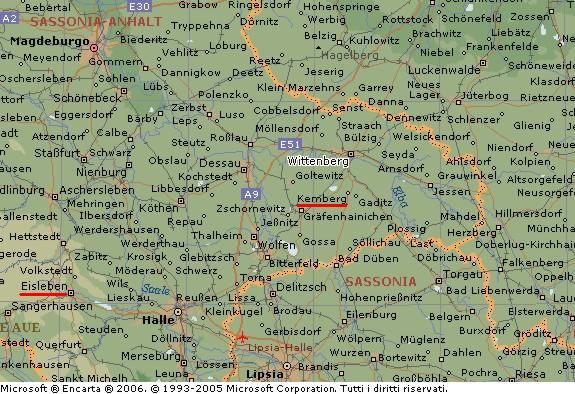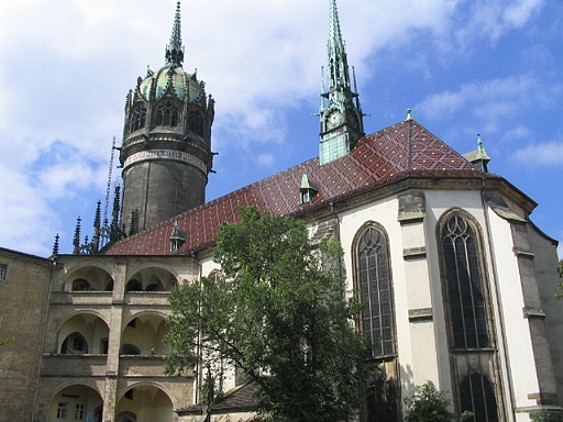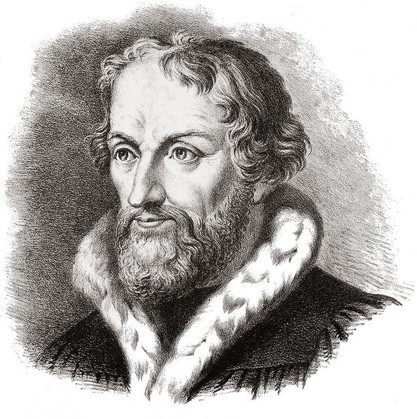Lessico
Wittenberg
Wittenberg,
citata anche come Wittenberga, è una città della Sassonia-Anhalt (Germania)
di 46.133 abitanti, situata sul fiume Elba e con una superficie di 128,93 km².
L'importanza di Wittenberg è dovuta alla sua stretta correlazione con la
figura di Martin Lutero![]() e gli
inizi della Riforma protestante: molti degli edifici storici della città sono
associati con gli eventi di quel tempo. Parte del monastero agostiniano in cui
Lutero dimorò, prima come semplice monaco e successivamente come priore, si
è conservato fino ai giorni nostri ed è considerato uno dei principali musei
del mondo dedicati alla sua figura, contenente numerosi oggetti d'arte
medievali e ritratti eseguiti da Lucas Cranach il Vecchio e dal figlio. Nel
1997 Wittenberg è stata inserita nell'elenco dei Patrimoni dell'umanità
dell'UNESCO insieme ad Eisleben
e gli
inizi della Riforma protestante: molti degli edifici storici della città sono
associati con gli eventi di quel tempo. Parte del monastero agostiniano in cui
Lutero dimorò, prima come semplice monaco e successivamente come priore, si
è conservato fino ai giorni nostri ed è considerato uno dei principali musei
del mondo dedicati alla sua figura, contenente numerosi oggetti d'arte
medievali e ritratti eseguiti da Lucas Cranach il Vecchio e dal figlio. Nel
1997 Wittenberg è stata inserita nell'elenco dei Patrimoni dell'umanità
dell'UNESCO insieme ad Eisleben![]() , la città
in cui Martin Lutero nacque e morì, in virtù dei numerosi monumenti storici
a lui collegati.
, la città
in cui Martin Lutero nacque e morì, in virtù dei numerosi monumenti storici
a lui collegati.

La città
venne menzionata per la prima volta nel 1180 come un piccolo villaggio fondato
da immigrati provenienti dalle Fiandre![]() . Nel 1293
l'insediamento venne promosso a città e nei secoli successivi si sviluppò
soprattutto dal punto di vista commerciale a causa della sua invidiabile
posizione geografica. Wittenberg divenne famosa alla fine del XV secolo,
quando Federico III di Sassonia vi stabilì la sua residenza. In quei giorni
vennero costruite numerose strutture cittadine: un secondo ponte sull'Elba
(fra il 1486 e il 1490) e la Schlosskirche (fra il 1490 e il 1499), oltre alla
ricostruzione completa del palazzo di corte.
. Nel 1293
l'insediamento venne promosso a città e nei secoli successivi si sviluppò
soprattutto dal punto di vista commerciale a causa della sua invidiabile
posizione geografica. Wittenberg divenne famosa alla fine del XV secolo,
quando Federico III di Sassonia vi stabilì la sua residenza. In quei giorni
vennero costruite numerose strutture cittadine: un secondo ponte sull'Elba
(fra il 1486 e il 1490) e la Schlosskirche (fra il 1490 e il 1499), oltre alla
ricostruzione completa del palazzo di corte.

Schlosskirche
Fu la capitale del piccolo Ducato di Sassonia-Wittenberg, i cui regnanti divennero poi principi elettori, titolo conservato fino a metà del XVI secolo. Nel 1502 venne fondata l'università di Wittenberg, in cui insegnarono molti importanti pensatori dell'epoca, fra i quali lo stesso Lutero (professore di teologia a partire dal 1508) e Filippo Melantone (professore di greco dal 1518). Il 31 ottobre 1517 Martin Lutero appese le sue famose 95 tesi sulla porta principale della Schlosskirche contro la vendita delle indulgenze, fatto che è stato posto come data di inizio della Riforma protestante. Il movimento anabattista (gruppi cristiani detti anche catabattisti che a partire dal sec. XVI si rifiutarono, sulla base di un rigoroso biblicismo, di battezzare i bambini) ebbe uno dei suoi primi punti di diffusione a Wittenberg quando tre esponenti del movimento vennero in città provenienti da Zwickau nel 1521, solo per essere cacciati da Lutero quando egli ritornò da Wartburg nel 1522.

Filippo
Melantone
Philipp Schwarzerd (Bretton 1497 - Wittenberg 1560)
Nel 1760 la città venne bombardata dagli austriaci e, nel 1806, occupata dalle truppe francesi di Napoleone. Nel 1815 venne conquistata dalla Prussia, restando una delle fortezze dell'impero fino al 1873. Durante la seconda guerra mondiale Wittenberg venne risparmiata dai bombardamenti degli Alleati, che strinsero un accordo in tal senso benché nella città si combattesse (cosa testimoniata per esempio dai fori di proiettile sulle statue di Martin Lutero e Melantone). Alla fine della guerra Wittenberg venne occupata dalle truppe sovietiche e, nel 1949, divenne parte della Germania Est. Dopo la rivoluzione pacifica del 1989 il Partito Socialista Unificato Tedesco, fino allora al potere, venne esautorato e a partire dal 1990 la città fa parte della Germania riunificata.
La Schlosskirche, del XV secolo, è il più noto monumento della città. I suoi portali in legno vennero bruciati durante un bombardamento nel corso della guerra dei sette anni, per poi essere ricostruiti e restaurati alla fine del XIX secolo. Nel 1858 le porte in legno vennero sostituite da porte in bronzo, su cui venne inciso in latino il testo delle 95 tesi di Lutero. All'interno della chiesa si trovano le tombe di Lutero e di Melantone, oltre che quelle di Federico il Saggio (realizzata nel 1527 da Peter Vischer) e di Giovanni di Sassonia (realizzata da Hans Vischer).
La chiesa di Santa Maria (Stadtkirche), la parrocchiale in cui spesso Martin Lutero predicava, venne eretta nel XIV secolo ma è stata successivamente profondamente modificata. All'interno della chiesa è presente un famoso dipinto di Lucas Cranach il Vecchio raffigurante l'Ultima Cena, in cui compaiono i volti di Lutero e dei riformatori. Altri luoghi storici della città sono: l'antico palazzo in cui risiedeva il Principe Elettore, gravemente danneggiato nel 1760 e che oggi contiene gli archivi della città; la casa di Melantone e di Cranach il Vecchio, che fu anche sindaco di Wittenberg; statue di Lutero e Melantone; il sito in cui Lutero il 10 dicembre 1520 bruciò pubblicamente la bolla papale Exsurge Domine, in cui oggi sorge una quercia.
Wittenberg ha una lunga tradizione per quanto riguarda gli eventi culturali. Durante gli anni della Germania Est il teatro della città, il Mitteldeutsches Landestheater, era considerato uno dei più importanti a livello europeo. Dal 1996 a Wittenberg si tengono spettacoli all'aperto basati sulla storia luterana, sullo sfondo dei luoghi storici in cui accaddero gli eventi. Nel 2001 e nel 2005 la direzione artistica di tali spettacoli, denominati "Bühne Wittenberg", viene presa da Fernando Scarpa, che realizza messinscene che hanno riscosso consensi a livello non solo nazionale.
Wittenberg, officially Lutherstadt Wittenberg, is a town in Germany in the Bundesland Saxony-Anhalt, on the Elbe River. It has a population of about 50,000. The importance of Wittenberg historically was due to its seat of the Elector of Saxony, a dignity held by the dukes of Saxe-Wittenberg and also to its close connection with Martin Luther and the dawn of the Protestant Reformation; several of its buildings are associated with the events of this time. Part of the Augustinian monastery in which Luther dwelt, first as a monk and later as owner with his wife and family, is preserved and considered to be the world's premier museum dedicated to Luther.
A settlement was mentioned first in 1180 as a small village founded by Flemish colonists under the rule of the House of Ascania. In 1260 it became the residence of the dukes of Saxe-Wittenberg and in 1293 the settlement was granted a town charter. Wittenberg developed into an important trade centre during the following centuries, due to its location. When the Ascanians died out, Saxe-Wittenberg passed to the House of Wettin. The city became an important regional political and cultural centre at the end of the 15th century, when Frederick III "the Wise", Elector of Saxony, took up residence in Wittenberg. Several parts of the city were extended soon afterward: the second bridge over the Elbe was built from 1486 to 1490 and the castle church, the Schlosskirche, was built from 1496 to 1506. The palace was rebuilt the same time.
In 1502 the University of Wittenberg was founded and gave a home to many important thinkers, among them Martin Luther (Professor of Theology from 1508) and Philipp Melanchthon (Professor of Greek from 1518). On October 31 1517, Luther nailed his 95 theses against the selling of indulgences at the door of the All Saints', the Castle Church, marking the beginning of the Protestant Reformation. The Anabaptist movement also had one of its earliest homes in Wittenberg, when the Zwickau prophets moved there in late 1521, only to be suppressed by Luther when he returned from the Wartburg in spring 1522. The Capitulation of Wittenberg (1547) is the name given to the treaty by which John Frederick the Magnanimous was compelled to resign the electoral dignity and most of his territory to the Albertine branch of the House of Wettin.
In 1760 during the Seven Years' War, the Prussian-occupied town was bombarded by the Austrians. It was occupied by the French in 1806, and refortified in 1813 by command of Napoleon. In 1814 it was stormed by the Prussian Army under Tauentzien, who received the title of "von Wittenberg" as a reward. In 1815 Wittenberg became part of Prussia and was administered within the Province of Saxony. Wittenberg continued to be a fortress of the third class until the reorganization of German defenses after the foundation of the new German Empire led to its being dismantled in 1873.
Unlike many other historic German cities during World War II, Wittenberg was spared destruction during the war. The Allies agreed not to bomb Wittenberg, though there was fighting in the city, with bullet pock-marks visible on the statues of Luther and Melanchthon at the market square, or so the popular version of the city's history goes. In actuality, the Luther statue was not even present in the city square during much of the war. It was stored at Luther Brunnen, a roadhouse only a few kilometers north of the city.
Wittenberg's reputation as a city protected from Allied bombing is also not historically accurate. There was on the outskirts of Wittenberg the Arado Flugzeugwerke (Arado Aircraft Factory), which produced aircraft components for Hitler's airforce. The factory was staffed by Jews, Russians, Poles, political prisoners, and even a few Americans - all prisoners engaging in forced labor. Despite the prisoner status of its workers, American and British planes bombed the factory near the end of WWII. One thousand prisoner workers were killed. The recent publication of "...und morgen war Krieg!" by Renate Gruber-Lieblich attempts to document this tragic bombing of Wittenberg. At the end of the war, Wittenberg was occupied by Soviet forces, and became part of the German Democratic Republic in 1949. By means of the peaceful revolution in 1989, the communist regime was brought down and the city has been governed democratically since 1990.
Wittenberg is home to numerous important historical artifacts, as well as portraits and other paintings by the Cranachs. On the doors of All Saints' Church, the Schlosskirche ("castle church" built 1496–1506) Luther nailed his 95 theses in 1517. It was seriously damaged by fire in 1760 during a bombardment by the French during the Seven Years' War, was practically rebuilt, and was later (1885–1892) restored. The wooden doors, burnt in 1760, were replaced in 1858 by bronze doors, bearing the Latin text of the theses. Inside the church are the tombs of Luther and Philipp Melanchthon, and of the electors Frederick the Wise (by Peter Vischer the Younger, 1527) and John the Constant (by Hans Vischer), and portraits of the reformers by Lucas Cranach the Younger. St. Mary's Church, the parish church in which Luther often preached, was built in the fourteenth century, but has been much altered since Luther's time. It contains a magnificent painting by Lucas Cranach the Elder, representing the Lord's Supper (with the faces of Luther and other reformers), Baptism and Confession, also a font by Hermann Vischer the Elder (1457). In addition, there are numerous historic paintings in the church. The ancient electoral palace is another of the buildings that suffered severely in 1760; it now contains archives. There are also Melanchthon's house and the house of Lucas Cranach the elder (1472–1553), who was mayor of Wittenberg. Statues of Luther (by Schadow), Melanchthon and Bugenhagen embellish the town. The spot outside the Elster Gate where Luther publicly burned the papal bull in 1520 is marked by an oak tree.
Wittenberg's oldest arms
Wittenberg's civic coat of arms conveys with its various heraldic elements something of the town's history. On 27 June 1293, Wittenberg was granted town rights by Duke Albrecht II. There then arose a mediaeval town whose highest governing body was its council. This council, known to have existed as early as 1317, was given the job of administering the town in its care through law and legislation, and of handling the town's revenue. For documentation, the administration used its own seal. One version of what is believed to be the town's oldest town seal, which the council used, and which dated from the first half of the 14th century, set the pattern with its elements for various civic coats of arms down to the present day.
The coat of arms symbolizes, with its crenelated wall and the towers within and each side, a town that was already strongly fortified by 1409. The two shields in the centre form the coat of arms of the Electorate of Saxony with the Saxon arms on the right, whose gold and black stripes recall the Ascanian rulers' house colours with the Rautenkranz (literally "lozenge wreath", although it is no such thing, as can be seen at the Saxony article) across them symbolizing the town's founder Duke Albrecht II since 1262, when it appeared in his arms. The shield on the left is the Wittenberg district's arms. In 1356, Emperor Charles IV bestowed upon the Duke of Saxony-Wittenberg the honour of Elector. Wittenberg became an Electoral residence. The shield with its crossed swords stands for the office of "Arch-Marshal of the Holy Roman Empire" inextricably joined by the Electorate, brought to Wittenberg by Rudolf I. Both coats of arms continued to be used by the Wettins after the Ascanians died out. The flowing water at the foot of the shield symbolizes Wittenberg's location on the river Elbe. The fish is a salmon, which were once abundant in the Elbe. The fishermen, like all professions in town, got their own order in 1422, and the fish found its way onto their coat of arms.
Wittenberg has a long tradition in cultural events. The City Theatre Mitteldeutsches Landestheater reached a great importance in GDR times. Since 1996, the City proposes Open-Air theatre shows based on the Lutheran history still alive in many historical places of the ancient town. As highlights, in 2001 and 2005, Fernando Scarpa became the artistic director of the "Bühne Wittenberg" (Stage Wittenberg), a project for theatre, art and culture in the whole of Germany which attracts to the City plenty of audience and whose success achieves European echo. Hamlet and Dr Faustus are said to have studied here.